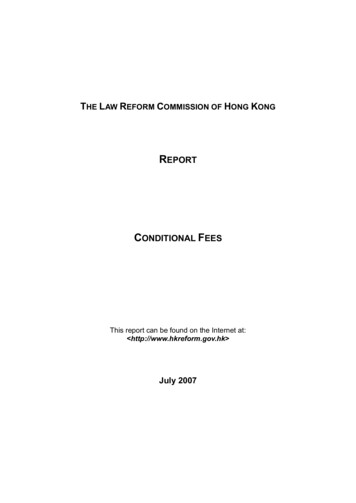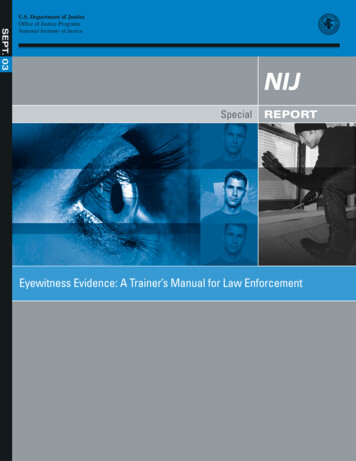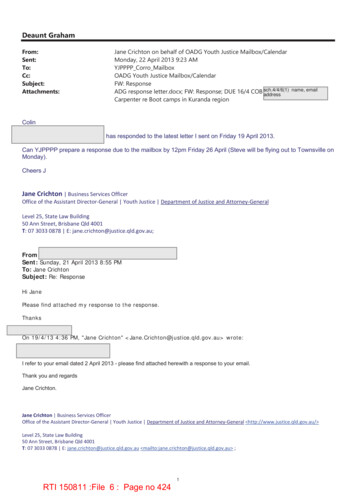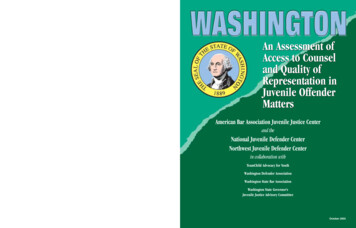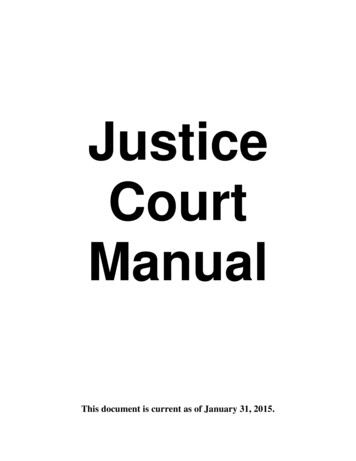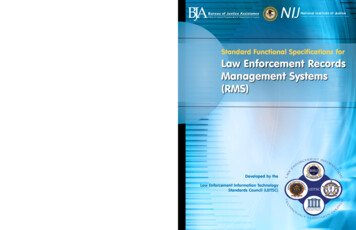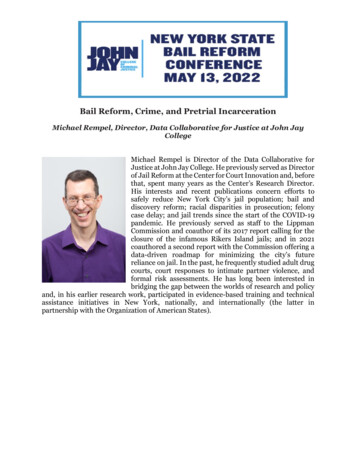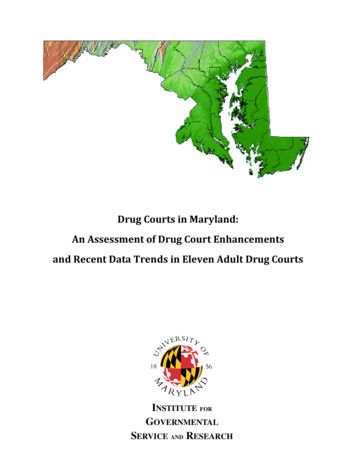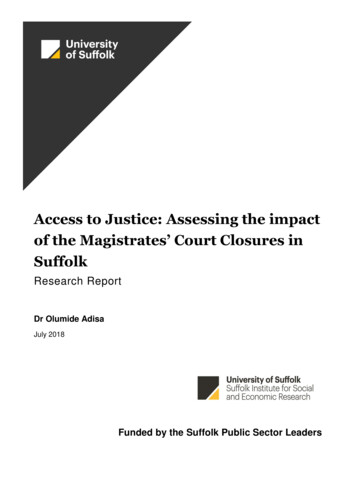
Transcription
Access to Justice: Assessing the impactof the Magistrates’ Court Closures inSuffolkResearch ReportDr Olumide AdisaJuly 2018Funded by the Suffolk Public Sector Leaders
DISCLAIMERWhile every effort has been made to ensure that theinformation contained in this draft report is accurate andup-to-date, neither authors can accept legal responsibilityor liability for anything done by readers as a result of anyerrors or omissions.All rights reserved. No part of this publication may bereproduced, stored in a retrieval system or transmitted inany form, or by any means, electronic, mechanical,photocopying, recording or otherwise, without priorpermission of the publishers.Published by:University of SuffolkWaterfront BuildingIpswichSuffolkIP4 1QJ
CONTENTSAcknowledgements . 3Foreword . 4Executive Summary . 6123Introduction . 111.1Background . 111.2Objectives . 12Methodology . 132.1Research Questions . 132.2Research Design. 132.3Limitations . 162.4Report Structure . 16Evidence Base: Assessing Impact . 173.1Impact on Defendants and Defence Witnesses . 173.2Impact on Offenders (Probation’s Perspective) . 193.3Impact on Victims and Prosecution Witnesses . 193.4Impact on Criminal Justice System Agencies and Ipswich Magistrates’ Court . 214Are the non-appearances leading to disruption in court procedures? . 265Are the court facilities adequate to deal with the increased demand? . 286Conclusions . 407References . 41Appendices . 421
TablesTable 2-1: Interviewees by stakeholder group . 14Table 3-1 : Evidence type and observed impact of court closures on defendants, victims andwitnesses in Suffolk . 17Table 3-2: Pre- and post-court closure costs on Haverhill-based defendants and defencewitnesses . 18Table 3-3: Average number of days taken from offence to completion for criminal cases inIpswich Magistrates' Court. 20Table 3-4: Evidence type and observed impact of court closures on criminal justice agenciesand professionals in Suffolk . 21Table 3-5: Serving Magistrates in Suffolk by demographics; 2012-2016. 23Table 3-6: Full breakdown of court closure cost reduction by cost type and year in Suffolk . 25Table 4-1: Type of defendants by location at IMC pre-and post-closure . 27Table 4-2: Failure to Appear warrants issued to defendants by location at IMC; Oct 15- Mar 16. 28Table 4-3: Failure to Appear warrants issued to defendants by location at IMC; Oct 16- Mar 17. 28Table 5-1: Suffolk Magistrates' Court Schedule post-closure; Oct 2016 - date. 29Table 5-2: Trial Performance at IMC between pre- and post-closure period . 34Table A: Average generalised costs of court users . 442
AcknowledgementsThis research study, commissioned by Suffolk’s Public Sector Leaders to examine thecourt closures in Suffolk took a life of its own and I’m grateful for the contributions andsupport of a great many people. I would like to thank the Police, Probation and SuffolkCounty Council for their support of the research and to their key staff for giving up theirvaluable time to be interviewed.I am truly grateful to the following people who helped me make contact with keystakeholders and provided advice and comments on preliminary findings: NeilWalmsley (Under Sheriff of Suffolk), Clare Euston—Countess of Euston (LordLieutenant of Suffolk), Geoffrey Probert (Former High Sheriff of Suffolk), and WilliamKendall (Former High Sheriff of Suffolk).At the start of the project, Hugh Rowland and Audrey Ludwig were helpful in suggestinglegal professionals to interview.Special thanks to members of the judiciary and senior court staff at Her Majesty’s Civiland Tribunals Service (HMCTS), particularly those at Ipswich Magistrates’ Court andthe Crown Court for their participation in the research. At the local level, Danny Cainand John Miller for their assistance in securing the court data used in the report andaiding the data verification process.I owe a debt of gratitude to the solicitors and defence advocates in Suffolk whogenerously gave of their time. I must specially thank the solicitor firms whose businessmodels have been affected by the court closures in West Suffolk, who were open todiscuss the challenges that the impact of the court closures have been having on theirclients and on them professionally.Professor Emma Bond, Director of Research at the University of Suffolk and ProfessorSimon Hallsworth (former Pro-Vice Chancellor, Faculty of Arts, Business and AppliedSocial Sciences) provided valuable input and comments on the report.3
ForewordThe Ministry of Justice announced the closure of the Magistrates’ Courts in Lowestoftand Bury St Edmunds at the end of 2016. This left the county of Suffolk with only onecourt house which is in Ipswich. Suffolk is a large rural county covering nearly 1,600square miles, contains over 480 villages and hamlets as well as the large towns ofIpswich, Lowestoft and Bury St Edmunds and a population of around 750,000 people.The increasing ability for criminal justice to employ digital and other technologies hasreduced the number of cases being heard with defendants and victims physicallypresent. That said, serious concerns were raised by the public and the legal professionto the Ministry of Justice during the consultation period and with other members ofSuffolk’s criminal justice system including the High Sheriff and the county’s Police andCrime Commissioner. These concerns focused mainly on suspicion/assumption thatthe court closure programme could adversely affect people’s access to justiceespecially those who were disabled or who had to rely on public transport from remoterural areas to attend court hearings.As the British criminal justice system is central to our way of life and a corner stone ofour unwritten constitution, the Suffolk Public Sector Leaders’ group funded anindependent assessment of the effects of the closure programme in Suffolk based onthe evidence and data available from the court so far.There would be little point in commissioning this work without deciding how and whatto do in the county for improving access to justice in future. This is a decision for SuffolkPublic Sector Leaders to take as quickly as possible and to then develop andimplement a viable and sustainable solution fit for the twenty first century, which couldthen be replicated nationwide.It is therefore down to the whole community of Suffolk to rise to this formidablechallenge and look forward to the next stage of work.Jennie JenkinsSuffolk Public Sector Leaders’ Chairman4
FiguresFigure 1: Map of Suffolk depicting the location of IMC . 11Figure 2: Trial Performance at Ipswich Magistrates Court, pre- and post-closure . 35Figure 3: Cases received at magistrates' courts in Suffolk (April 2015 – Mar 2017) . 35AbbreviationsIMCIpswich Magistrates’ CourtBSECBury St Edmunds Magistrates’ CourtBSEBury St EdmundsHMCTSHer Majesty’s Courts and Tribunals ServiceCPSCrown Prosecution ServiceMoJMinistry of JusticeSCCSuffolk County CouncilYOTYouth Offending TeamPICPolice Investigation CentreCJSCriminal Justice System5
Executive Summary In the last 8 years, the Ministry of Justice have closed over 90 regional courts in the UK aspart of its rationalisation strategy to achieve economic efficiency of its estates. In Suffolk,two out of three courts in Suffolk were closed as a result. The Lowestoft Magistrates’ Courtand Bury St Edmunds Magistrates’ Court (hereafter BSEC) were both closed by theMinistry of Justice and HMCTS in September and October 2016 respectively. With only one magistrates’ court serving the whole of the county, various stakeholders incriminal justice agencies and the legal community have expressed concerns that accessto justice could be compromised. Some believe that the HMCTS may have underestimatedthe difficulties that the court closures are having on court users, particularly those that livefurther away from Ipswich.“Court closures have been happening over the past few years. However, with ease oftransport improving this made sense. But to have only one court in Ipswich is likely tomake it difficult for those who are at a considerable distance from Ipswich to access it. Itmust be costing these people more to get to the Ipswich court.” - Member of the judiciary Suffolk’s Public Sector Leaders commissioned the University of Suffolk in March 2017 toinvestigate the impact of the court closures on those most affected, particularly on thosehaving to travel long distances. While the impact assessment was conducted betweenMarch 2017 and May 2017, the research period was extended to November 2017 to allowadditional time to include court data from the HMCTS. For comparison purposes, theresearch defined the pre-closure period as October 2015 – March 2016 and thecorresponding post-closure period as October 2016 – March 2017. The study used a combination of qualitative and quantitative methods to answer a set ofbroad research questions. Two unpublished consultation response reports sent to theHMCTS on the impact of the court closures by key stakeholders were used to contextualisesome of the research findings. Verified quantitative local court data drawn locally andcentrally from the HMCTS was used to provide information on the impact of the courtclosures. The research conducted interviews and focus groups with key stakeholders whorepresent the interests of various court users. These stakeholders work within the criminaljustice system and were selected using purposive sampling. As part of the research, the researcher undertook court observations and spent about 20hours at Ipswich Magistrates’ Court over the course of four weeks. Additionally, a half-dayvisit at Ipswich Crown Court was spent observing court proceedings (with permissiongranted by Ipswich crown court judges). Some of these observations formed the premiseof our exploratory conversations with members of the judiciary. Through stakeholder interviews and focus groups, the researcher collected accounts fromvarious stakeholders and verified comments that were made about a particular agency or6
the court with available factual data. The researcher also compared and contrasted viewsas a way to triangulate and to draw out themes about what the key impact of the courtclosures have been. For the convenience of the participants, telephone interviews wereconducted in some cases. These conversations with stakeholders revealed that people viewed the case allocation ofLowestoft cases to Great Yarmouth Magistrates’ Court favourably, due to the proximity ofLowestoft and Great Yarmouth. Therefore, the researcher focused the research primarilyon the BSEC closure and in understanding its impacts, if any. The data from the interviews and focus groups with key stakeholders suggests that therehave been negative and positive impacts to the court closures. The positive impacts havebeen largely beneficial to the courts, probation services, and the Crown ProsecutionService (CPS). However, particularly in the case of the CPS, we are not certain whetherthese benefits have been outweighed by the costs of centralisation. From the discussions,it is clear that certain groups of people (defendants, defence witnesses, and defenceadvocates) are perceived to have experienced more negative impacts of the court closuresthan court users on the prosecution side. From the quantitative analysis, the research has found that for some, the court closureshave led to a doubling of generalised costs (including travel time impacts). The quantitativedata from the courts revealed some pertinent questions in relation to: access to justice, thesustainability of IMC workloads, and the efficiency of the justice system as a whole. While the intention was not to make recommendations on how the current provision couldbe improved, stakeholders were keen to share how the issues brought on by the courtclosures could be improved. It is interesting to note that generally the HMCTS’ plan toexpand the use of virtual courts and use of technology to resolve accessibility andefficiency issues prompted legitimate concerns from members of the judiciary, probationand defence advocates, particularly around the issue of risk and vulnerability.7
Overall, the mixed-method evidence revealed that: The court closures are aggravating issues already present in the system.These issues, brought on by court reforms in relation to Legal Aid, and thefurtherance of the digitalisation agenda across criminal justice system agencies areto an extent contributing to non-appearances, low morale of criminal defenceprofessionals, inefficiencies in court procedures, and dis-engagement from thejudicial system. There are far greater generalised time costs for court users residing furtheraway from Ipswich. The court closure consultations conducted by HMCTSrevealed that travel time impacts was one out of the three issues that were of a keyconcern for respondents. However, this study goes further in using a sophisticatedmodel to provide a close approximation of the generalised (monetary and nonmonetary) costs that court users coming from remote rural and rural communitiesare likely to incur in attending court, taking into consideration approximate points oforigin and destination. There is a need for greater clarity regarding the alternative provisionproposals to improve accessibility. The key message here is that this alternativeprovision plan needs to take into consideration the diverse needs of court users inSuffolk, as there are no ‘one-size-fits-all’ solutions. The layout of the court building has made it challenging to meet the needs ofall court users, particularly criminal justice professionals. Additionally, theonly lift in the building is located in the public side, which has implicationsfor witnesses with mobility challenges. No modifications have been undertakento the court facilities at Ipswich Magistrates’ Court to meet the needs of all courtusers in Suffolk. Conversations with court staff revealed that no modifications wererequired as a consequence of the court closure so none has been undertaken,although routine maintenance work have been carried out (for example, toilet andkitchen refurbishment, heating and ventilation and security). The court closures have led to a loss of informal ‘human’ relationshipsbetween the court and the defence advocates working on behalf of theirclients. Prior to the closures, defence advocates at BSEC felt able to betteradvocate for their clients because they had a closer working relationship with theirlocal court officials who were just a few metres away. The court closures are weakening access to “local justice knowledge” due tothe Magistrates not being able to sit in their local courts. Data provided by thecourts suggests that the closures have not affected the number of sitting8
magistrates adversely, but the IMC confirmed that they lost some magistrates fromWest Suffolk when the courts closed but recruited over 10 magistrates based inand around Suffolk stakeholders, following the closures. The release of HMCTS court data by Ipswich Magistrates’ Court enabled thecompletion of the report. However, the approval and release processintroduced a significant delay in the research timelines. The local ‘Failure toAppear’ data and trial performance information from Ipswich Magistrates’ Courtenabled an assessment of the research questions: “has the rate of nonappearances increased following the closure of the regional courts, and are morewarrants now been issued by the courts as a consequence?”; and “can the newstructure for delivering summary justice cope with the increased demand now beingplaced upon it? How much have waiting times increased?” While non-appearances have been a persistent issue in the courts even before theclosures, the research examined the courts’ failure to appear warrants data bydefendant’s location before and after the closure to identify any changes in thewarrants data. Quantitative data from the courts revealed that preceding theclosures, warrants issued for defendants based in BSE were only 2.7% (n 5), butpost closure for the same area, warrants issued were 12.8% (n 39). For Sudburybased defendants, pre-closure warrants data was about 1.6% (n 3), while postclosure this was 4.6% (n 14), highlighting that geographical accessibility of acourt likely matters in the context of the closures. Additionally, warrants issuedpreceding closure for Ipswich-based defendants was 54.9% (n 101) while postclosure this was 33.6% (n 102). Defendants based out of the area representedabout 17.9% of warrants issued pre-closure (n 33); and post-closure was 27.6%(n 84). Additionally, the average numbers of days from charge to first listing beforeclosures was 34 days (October 2015 – March 2016), and 42 days after the closures(October 2016 – March 2017). First listing to completion data revealed that theprocess at Ipswich Magistrates’ Court took an average of 25 days pre-closure and24 days post-closure, suggesting that the closures have not affected processingtimes. Having said that, the proceedings at Magistrates’ Courts is only one aspectof the criminal justice process. The length of time victims are waiting to receivejustice has implications for the whole justice system and requires furtherinvestigation. Particularly for either way and indictable cases1, where the court1According to the CJS, either way offences (e.g burglary, actual body harm, drugs offences) are those that can beheard in either the Magistrate Court or Crown Court. The decision as to which court will hear the case is determinedat a Mode of Trial hearing. Indictable offences are always passed on to the Crown Court by the Magistrates’ Court.9
data revealed that processing times from offence to completion more than doubledin the post-closure period, compared to the pre-closure period. Trial performance data from HMCTS’s One Performance Truth database suggestsa slight improvement in efficiency at Ipswich Magistrates’ Court following the courtclosures: trial effectiveness was 44% for Ipswich Magistrates’ Court pre-closure,and cracked2 rate is 40%, while post-closure, this was about 47% and cracked ratewas 35%. Workload data revealed that workloads at Ipswich Magistrates’ Court have actuallybeen decreasing over the post-closure period compared to the corresponding preclosure period. Contextually, the courts revealed that the cases being sent toIpswich Magistrates’ Court by the prosecution have been on the decline. Onereason could be the increasing use of out-of-court disposals by the police, but thishas emerged as an area of further investigation. Generally, all the participants agreed that access to justice is a key principle that needs tobe preserved in any judicial system and that it is vital to identify those groups that are mostaffected by the court closures. It is for this reason that the research has beencommissioned, not to make recommendations per se but to provide an evidence-base thatwill enable policymakers to extend the discussion on improving sustainable access tojustice in Suffolk, in ways that are fair to all. Across the interviews, there were various concerns expressed on the impact of the courtclosures and suggestions about how alternative provision could help mitigate some of theaccessibility issues. We present some of these ideas in this report’s Appendix B.2Typical reasons for a cracked trial include late guilty plea accepted; guilty plea to alternative new charge; defendantbound over; prosecution end case. A trial can only be ‘cracked’ or ‘effective’ once in the duration of a case but itcan be ‘ineffective’ multiple times. A Guide to Criminal Statistics; Ministry of Justice 2016; and HMCTS’ OnePerformance Truth Database10
1 Introduction1.1 BackgroundIn the last 8 years, the Ministry of Justice have closed over 90 regional courts in the UK as partof its “Transforming Summary Justice” programme3. The thinking behind these closures wasa desire to rationalise court provision in order to achieve economic efficiency of its Estates. InSuffolk, two out of its three courts were closed as a result. In September and October 2016respectively, the Lowestoft Magistrates’ Court and Bury St Edmunds Magistrates’ Court wereboth closed by the Ministry of Justice and HMCTS. Suffolk is now left with only one magistrates’court, centred in Ipswich, which serves the whole of the county.Figure 1: Map of Suffolk depicting the location of IMC3Transforming the CJS: A Strategy and Action Plan to Reform, June 201311
Ward’s (2016) study on magistrates’ courts found that prior to the Courts Estate RationalisationProgramme starting in July 2009, there were 286 magistrates’ courts. The first phase of theclosures saw over 90 courts close in England and Wales. In February 2016, 86 courts wereearmarked for closure, including Suffolk’s Lowestoft and BSE courts.In Suffolk, the court closures precipitated a local campaign, which sought to challenge HMCTS’plan. Those behind the campaign articulated a series of concerns: first, that given the county’spoor transportation links, the closure of the courts serving more rural and remote areas ofSuffolk would impact negatively on those who lived in the vicinity of the courts that had beenclosed and who lived furthest from Ipswich. Second, the campaigners argued that centralisingcourt provision to Ipswich would lead to people disengaging from the criminal justice system.While the campaign was unable to stop the court closures, it led to a timed concession fromthe Minister of Justice, to the Suffolk Police and Crime Commissioner to come up with analternative plan, guaranteeing that access to justice will not be compromised for vulnerablegroups. Until now, there is little academic evaluation of the impact from magistrates’ courtclosures.Magistrates’ courts are typically considered to be the loci of local justice within communities inthe UK. As a majority of cases in the criminal justice system begin at the magistrates’ court4,closing them can have detrimental effects on the community that they serve, particularly inrelation to access to justice – one of the key principles of the HMCTS.51.2 ObjectivesThe objectives of this impact assessment study were to: Assess the impact of the court closures on communities where court services havebeen discontinued in Suffolk Establish if the provision of justice and access to it has been compromised by theclosure of the regional courts Where appropriate, provide an evidence-base to enable policy makers to assess anddetermine the extent to which the new structure for delivering summary justice is fit forpurpose.4While majority of cases are criminal proceedings, it is worth noting that criminal proceedings heard in themagistrates courts may also include civil claims in some cases, for example civil confiscation claims under theProceeds of Crime Act 2002.“Ensuring Access to Justice: To ensure continued access to justice when assessing the impact of possibleclosures taking into account journey times for users when journeys will be significantly increased.” MoJ5Decision Impact Assessment (HMCTS, Principle 9b, sub section1, p.4)12
2 Methodology2.1 Research QuestionsThe evaluation addressed the following broad research questions:1. How do the closures impact upon victims, defendants, and witnesses as well as theagencies that work with them?2. How are Ipswich Court Services coping with the expanding workload, following theclosure of the regional courts?3. Are Ipswich court facilities adequate?4. Are the needs of users met in ways that ensure that the provision of justice remainsfair and accessible to all?5. To what extent are the problems of access potentially leading to disengagement fromthe judicial process? Has the rate of non-appearances increased following the closureof the regional courts and consequently, are more warrants now being issued by thecourts?6. Can the new structure for delivering summary justice cope with the increased demandnow being placed upon it? How much have waiting times increased?7. What are the added on-costs for statutory and non-statutory agencies, following theclosures?8. Is the current system sustainable?2.2 Research DesignThe study used a single-embedded case study approach (Yin, 2009), which defines the case(magistrates’ court closures in Suffolk) as embedded within the context of transformingsummary justice. The units of analysis within the study are a combination of qualitative andquantitative methods. These units of analysis (stakeholder interviews and court data) havebeen used to answer the research questions.The research has used a mixed-method approach to increase the depth and consistency ofthe study’s findings (Flick, 2006:390).13
Due to the short timeframe of the research, stakeholder interviews with professional courtusers were undertaken using a purposive sampling technique. As the court cases at theLowestoft Magistrates’ Court have been moved to Great Yarmouth Magistrates’ Courtfollowing the closure, the majority of stakeholders agreed that it was a welcome developmentdue to the proximity of Lowestoft and Great Yarmouth. Therefore, the research focused on theBSEC closure and in understanding its impacts.Stakeholder Telephone Interviews and Focus GroupsA total 18 stakeholders (n 18) working in the criminal justice agencies were involved in theresearch. A thematic analysis was used to identify relevant themes and to interpret thequalitative data from the interviews and focus groups. For accuracy and to capture voice(Poland 1995; Poland, 2003), verbatim quotations and statements from participants have beenused liberally in the report. The table below details the stakeholder participants and the natureof the research for each group.Table 2-1: Interviewees by stakeholder groupStakeholder GroupDefence Advocates6 (BSE-based andsurrounding areas)Defence Advocate (Haverhill)PoliceProbationSuffolk County Council(Youth Offending Team)Magistrates and Crown Court JudgesIpswich Magistrates’ CourtNumber ofparticipantsDepth Interviews (DI) /Focusgroups (FG)3FG1511DIFGDIDI61DIDIThe sampling strategy was based on identifying the key people in the Criminal Justice Systemwho would have first-hand knowledge of the impact from the court closures. A preliminarymeeting of key people working in the stakeholder groups listed above (as well as Suffolk’sPolice and Crime Commissioner) had been held at a Marriage Hall meeting early in the year,and this group of people facilitated speedy access to participants.Semi-structured interviews were undertaken with key stakeholders who had a greatunderstanding of the challenges that the victims, witnesses and defendants are facing.Additionally, these stakeholders provided case studies, which helped shed some light on howthese groups are being affected, and the extent to which they are coping.Through conversations, the researcher collected accounts from various stakeholders andusing factual data to verify comments that were made about a particular agency or the court.6One of the lawyers also practiced family law14
We compared and contrasted views as a way to triangulate and to draw out themes aboutwhat the key issues are following the court closures.Telephone interviews were conducted in some cases with professionals.
and Bury St Edmunds at the end of 2016. This left the county of Suffolk with only one court house which is in Ipswich. Suffolk is a large rural county covering nearly 1,600 square miles, contains over 480 villages and hamlets as well as the large towns of Ipswich, Lowestoft and Bury St Edmunds and a population of around 750,000 people.



